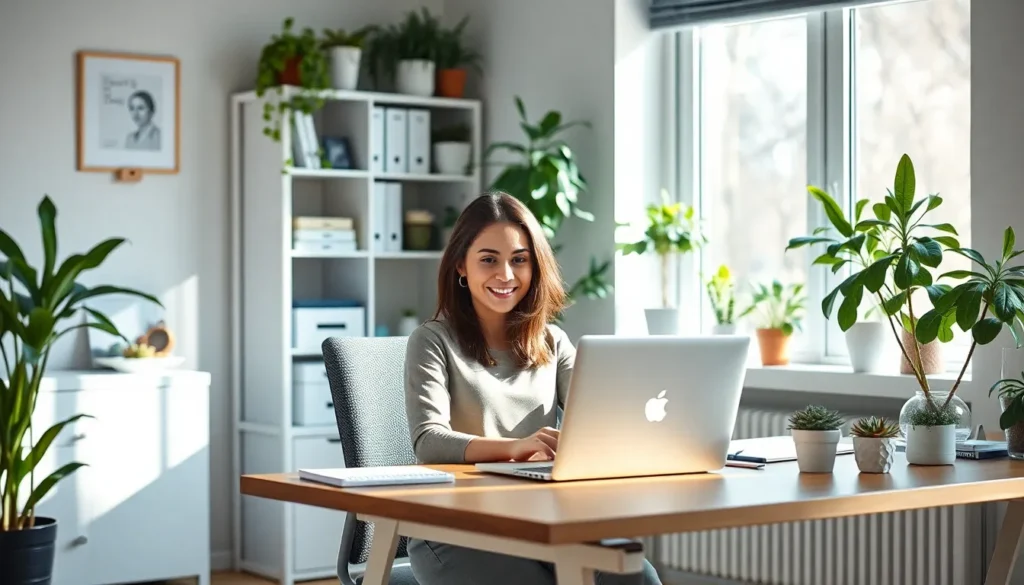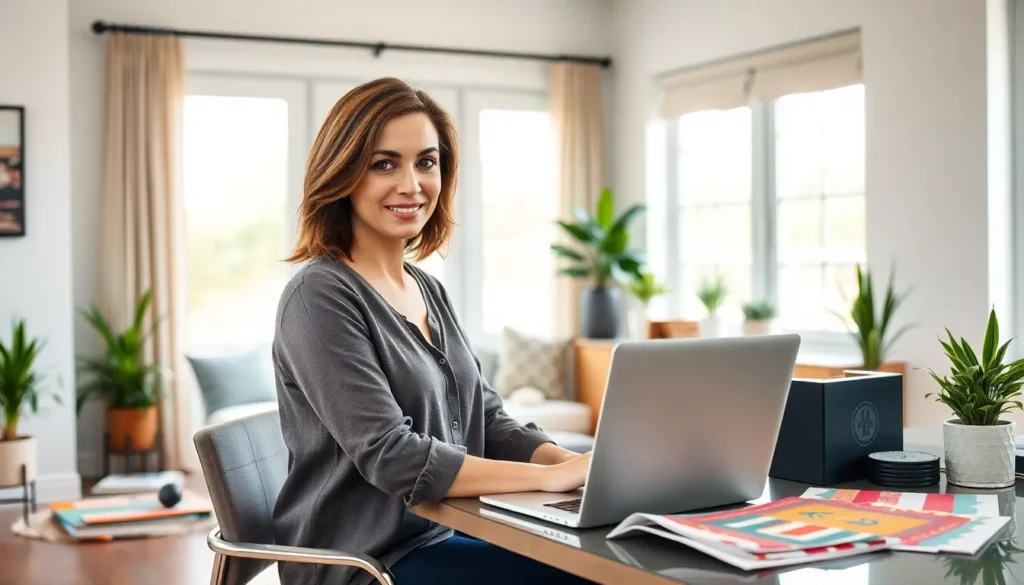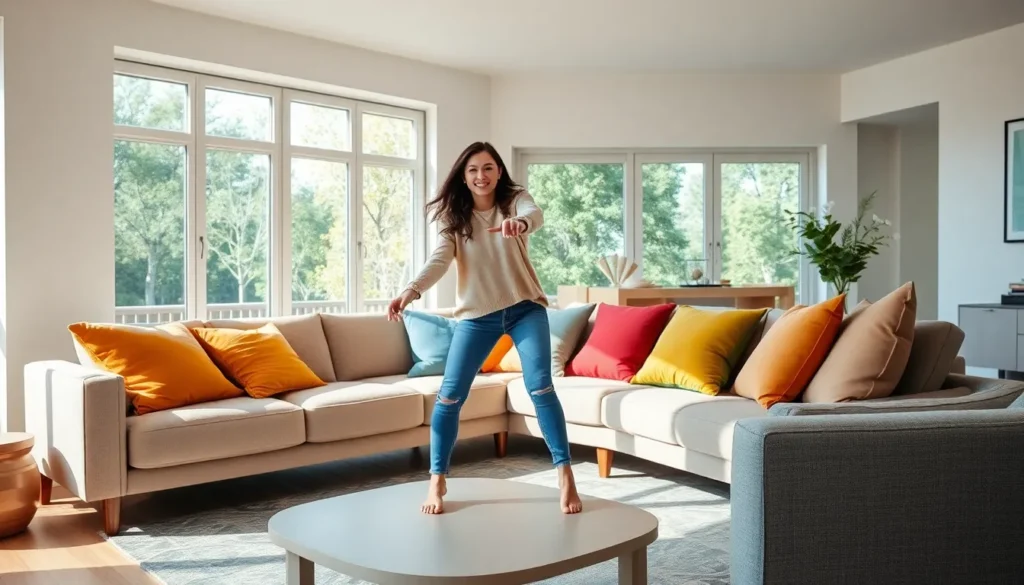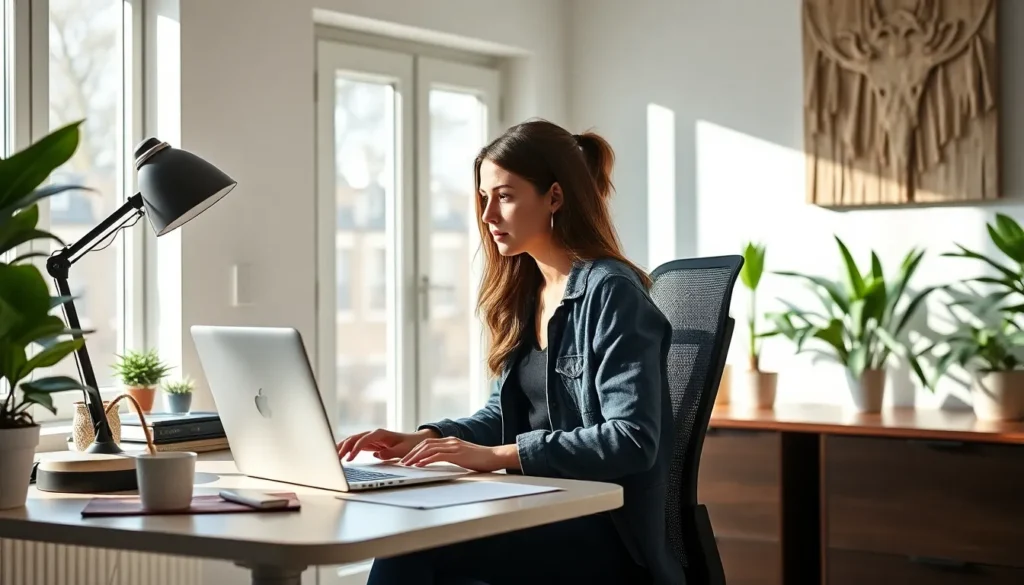In a world where working in pajamas has become the norm, creating a home office that inspires productivity is more important than ever. Gone are the days of balancing a laptop on your knees while lounging on the couch. It’s time to transform that cluttered corner into a workspace that makes you feel like a CEO—even if your only meeting is with a houseplant.
Table of Contents
ToggleImportance Of Home Office Design
Designing an effective home office plays a critical role in achieving professional success. A well-planned workspace can significantly impact overall performance and well-being.
Productivity Boost
Creating a dedicated work environment enhances focus. Studies show that individuals working in a thoughtfully designed space experience a 15% increase in productivity. Efficiency rises when distractions minimize and organization increases. Natural light contributes positively to energy levels, while ergonomic furniture supports better posture. Workspace arrangement also encourages a smoother workflow, making it easier to transition between tasks. These factors collectively foster a productive atmosphere that supports goal completion.
Enhanced Comfort
Comfort is essential for maintaining stamina during long work hours. Proper seating and desk height reduce strain on the body, allowing for longer periods of concentration. Incorporating personal touches, like favorite décor or plants, makes the space inviting. A balanced blend of aesthetics and functionality creates an environment that promotes creativity. When comfort levels rise, motivation flourishes, leading to improved job satisfaction. Tailoring the office to individual preferences enhances overall comfort and work-life balance.
Key Elements Of Home Office Design

Creating an effective home office involves careful consideration of various essential elements. A well-designed space enhances productivity and fosters a professional atmosphere.
Furniture Selection
Choosing the right furniture greatly impacts functionality and comfort. Ergonomic chairs provide support during long hours, minimizing discomfort and reducing strain on the body. Desks should offer ample workspace, ideally adjustable to accommodate different tasks. Storage solutions like shelves and cabinets help maintain organization, making essential items easily accessible. Personal touches, such as decorative accessories or plants, can also add character to the space, enhancing motivation. Selecting durable materials ensures longevity and allows for easy maintenance.
Lighting Considerations
Lighting plays a crucial role in setting the mood and improving focus. Natural light boosts morale and enhances productivity, so positioning a desk near windows maximizes its benefits. Task lighting, such as desk lamps, provides additional illumination for specific activities, reducing eye strain. Dimmers can create a customizable ambiance, catering to different work requirements. Incorporating various light sources, like overhead lights and floor lamps, creates depth in the workspace. Prioritizing well-lit areas promotes a positive environment and maintains energy levels throughout the day.
Designing For Different Spaces
Effective home office design adapts to various environments, maximizing productivity in any setting. Each space requires distinct strategies for optimal organization and functionality.
Small Space Solutions
Small spaces often demand creative solutions to enhance functionality. Utilize vertical storage options like shelves and wall-mounted organizers. Compact desks with built-in storage optimize every inch without sacrificing style. Incorporating multi-purpose furniture, such as foldable chairs, maximizes versatility. Additionally, using light color palettes can create an illusion of depth, making confined areas feel more spacious. Focus on minimizing visual clutter to maintain a clean and inviting atmosphere. Following these guidelines can help transform small areas into efficient workspaces that foster concentration.
Open Concept Offices
Open concept offices present unique challenges and opportunities for design. To reduce distractions, designate specific zones for different activities. Use area rugs or furniture arrangements to create boundaries within the space. Strategically placed plants can improve air quality while adding aesthetic appeal. Acoustic panels further enhance a quiet environment, promoting better focus. Shared spaces benefit from adaptable furniture that supports collaboration and individual work. Incorporating communal tables allows for flexibility while maintaining a professional atmosphere. With intentional design choices, open concept offices can effectively balance collaboration and individual productivity.
Popular Design Styles
Home office design showcases diverse styles that enhance productivity and reflect personal tastes. Different design approaches cater to varying preferences and functional needs.
Minimalist Approach
A minimalist approach emphasizes simplicity and functionality. This style promotes a clutter-free workspace, allowing focus on essential tasks. Neutral color palettes paired with clean lines create an open atmosphere. Furniture selection often includes streamlined desks and ergonomic chairs without unnecessary embellishments. The goal remains achieving calm and order, which can significantly reduce distractions. Personal items like a single plant or an inspiring print add character while maintaining minimalism.
Industrial Aesthetic
The industrial aesthetic offers a blend of raw materials and modern design. Exposed brick walls and metal accents characterize this look, creating a unique workspace. Large windows enhance natural light, making the environment inviting. Furniture typically consists of wooden desks with metal frames, aligning with the rugged theme. This style encourages creativity and innovation by incorporating various textured elements. Additionally, using vintage finds or repurposed items contributes to a cozy yet professional atmosphere, perfect for freelancers or creatives.
Creating an effective home office design is more than just aesthetics; it’s about fostering a space that enhances productivity and well-being. By carefully selecting ergonomic furniture and maximizing natural light, individuals can significantly improve their work experience. Personal touches not only add character but also inspire motivation and creativity.
Whether working in a small nook or an open space, intentional design choices can transform any area into a focused environment. Embracing different styles like minimalism or industrial design allows for a workspace that reflects personal taste while promoting efficiency. Investing time and effort into home office design ultimately leads to a more satisfying work-life balance and improved professional success.





